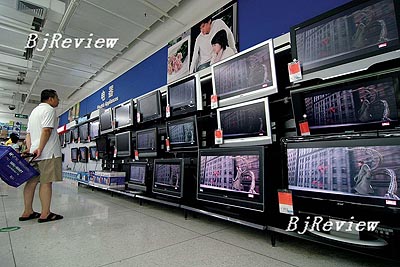|

With a set-top box worth about 1000 yuan installed on your ordinary TV set, you can not only view hundreds of TV programs, but also speculate on stocks, send e-mails, shop online and request programs. Such a computer-like multifunctional TV is the highly anticipated "digital TV."
By the end of 2006, the number of China's digital cable TV users had hit 12.67 million. According to the market research firm Analysys International, this number will increase to 25.73 million by 2007 and over 100 million by 2010.
By 2015, China will have seen an analog-to-digital transition take place nationwide, during which time the value of the domestic digital TV market will increase considerably from the 2002 mark of 40 billion yuan to an expected 500 billion yuan. The total value of the digital TV market is expected to reach 1.5 trillion yuan with immense market potential.
Integrated digital TV to prevail
The latest forecast by iSuppli shows that integrated digital TV will outnumber ordinary analog TV by the end of 2008. This indicates that terrestrial integrated digital TV will become the mainstream of the future digital TV thanks to its broad application prospects.
It has been three years since China started its migration to digital TV. Zhang Haitao, Vice Director of the State Administration of Radio, Film and Television (SARFT) said that 25 cities have completed their initial digitization of cable television.
Back in 2003, SARFT began to digitize radio and television service through cable TV and has worked out a preliminary digital cable TV migration mode that makes television a multimedia terminal offering comprehensive information and services.
According to industry experts, TV digitization requires the fusion of communication, radio and TV broadcasting networks. In addition, a new digital TV industry chain must be developed so that the content providers, content integrators and distributors, transmission platform operators and terminal equipment suppliers can find their right place on this chain.
Much has been invested in the radio and television industries for digitization. Some core technologies with independent intellectual property rights have been developed, including mobile multimedia broadcasting, a new generation of satellite transmission and digital movie mobile playing system, said Zhang.
The introduction of the new standards has further stimulated TV manufacturers. Tempted by huge profits, TV manufacturers have sped up production and are focusing on the new, related products.
It has been reported that major television makers such as Hisense, Skyworth, Konka, Changhong and TCL have begun to release integrated digital TVs and are trying to market their new products with help from local radio and TV operators.
GB chip takes the lead
The two standards of digital TV proposed by Tsinghua University and Shanghai Jiao Tong University have always been a topic of discussion among digital TV chip vendors. The dispute over which chip to favor was finally settled on August 1. Domestic digital TV will adopt the mature technology of the 0.18 micron chip. This type of unification of key technologies will hopefully bring along further fusion of industry standards.
Not wanting to miss the opportunity, domestic chip vendors have launched GB (guo biao: China national standard) supportive chips and have provided solution proposals in order to seize more market share in the future.
Zhou Bengen, Vice President of Shanghai Fudan Mironano Electronics Co. Ltd., said, "The Zhongshi No.2 demodulation chip is fully conformable to the national standards and will be launched very soon."
At the 15th annual conference of China Content Broadcasting Network (CCBN) held from March 30 to April 1 this year, Shanghai High Definition Digital Technology Industrial Co., one of the leading domestic companies focusing on terrestrial digital TV transmission standards, officially released their digital TV demodulation chip which conforms to industry standards.
Legend Silicon Corp. also exhibited their series of GB supportive demodulation chips at the show. Some of their latest products incorporating demodulation chips were also displayed, including terrestrial digital TV set-top boxes, integrated digital TV sets, and digital TV signal transmitters and receivers.
International semiconductor giants ST Microelectronics and ADI have also cooperated with Legend Silicon Corp. and released their solution for GB supportive terrestrial digital TV transmission standards.
Post-transition era
Ever since the official launch of the integral shift to digital TV last year, there has been a great increase in digital TV user numbers throughout China. For instance, Beijing Gehua CATV Network Co. Ltd. has converted 300,000 households to digital, accounting for one 10th of all cable TV subscribers in Beijing. This number is expected to hit 800,000 by the end of the year.
| 